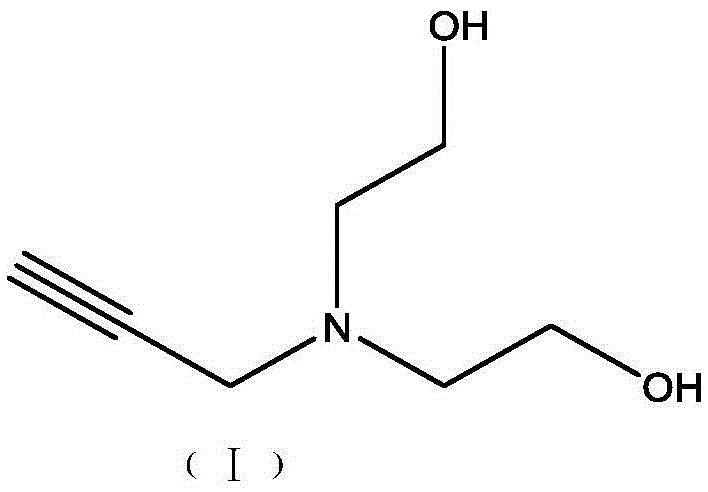Method for synthesis and purification of bonding agent N-propargyl diethanol amine
A technology of propargyldiethanolamine and a purification method, which is applied in chemical instruments and methods, preparation of organic compounds, preparation of aminohydroxyl compounds, etc., can solve problems such as non-environmental protection, complicated process, low yield, etc., and achieve an increase in yield , The effect of simple process
- Summary
- Abstract
- Description
- Claims
- Application Information
AI Technical Summary
Problems solved by technology
Method used
Image
Examples
Embodiment 1
[0022] The three-necked flask is equipped with mechanical stirring, a thermometer and a constant pressure dropping funnel, and is cooled by an ice-salt bath. First add 105 g of diethanolamine, 120 g of triethylamine, and 200 g of tetrahydrofuran. After cooling to 0° C., slowly add 126 g of 3-bromopropyne dropwise. The reaction is exothermic, and the temperature of the dropwise addition is controlled so that the temperature of the reaction solution does not exceed 25°C. After the addition, the reaction is continued with natural stirring for 3 hours.
[0023] After stopping the reaction, the reaction solution was filtered with suction to remove the salt generated by the reaction. The filtrate was transferred to a rotary evaporator, and tetrahydrofuran, unreacted 3-bromopropyne and triethylamine were evaporated under the conditions of a temperature of 50° C. and a vacuum of 10 mmHg. The crude product is then transferred to a vacuum distillation unit, rectifying under the conditi...
Embodiment 2
[0033] The three-necked flask is equipped with mechanical stirring, a thermometer and a constant pressure dropping funnel, and is cooled by an ice-salt bath. First add 105 g of diethanolamine, 101 g of triethylamine, and 200 g of tetrahydrofuran. After cooling to 0° C., slowly add 119 g of 3-bromopropyne dropwise. The reaction is exothermic, and the temperature of the dropwise addition is controlled so that the temperature of the reaction solution does not exceed 25°C. After the addition, the reaction is continued with natural stirring for 3 hours.
[0034] After stopping the reaction, the reaction solution was filtered with suction to remove the salt generated by the reaction. The filtrate was transferred to a rotary evaporator, and tetrahydrofuran, unreacted 3-bromopropyne and triethylamine were evaporated under the conditions of a temperature of 50° C. and a vacuum of 10 mmHg. The crude product is then transferred to a vacuum distillation unit, rectifying under the conditi...
Embodiment 3
[0036] The three-necked flask is equipped with mechanical stirring, a thermometer and a constant pressure dropping funnel, and is cooled by an ice-salt bath. First add 105 g of diethanolamine, 101 g of triethylamine, and 200 g of tetrahydrofuran. After cooling to 0° C., slowly add 119 g of 3-bromopropyne dropwise. The reaction is exothermic, and the temperature of the dropwise addition is controlled so that the temperature of the reaction solution does not exceed 25° C. After the addition, the reaction is continued with natural stirring for 2.5 hours.
[0037] After stopping the reaction, the reaction solution was filtered with suction to remove the salt generated by the reaction. The filtrate was transferred to a rotary evaporator, and tetrahydrofuran, unreacted 3-bromopropyne and triethylamine were evaporated under the conditions of a temperature of 50° C. and a vacuum of 10 mmHg. The crude product is then transferred to a vacuum distillation unit, rectified under the condi...
PUM
 Login to View More
Login to View More Abstract
Description
Claims
Application Information
 Login to View More
Login to View More - R&D
- Intellectual Property
- Life Sciences
- Materials
- Tech Scout
- Unparalleled Data Quality
- Higher Quality Content
- 60% Fewer Hallucinations
Browse by: Latest US Patents, China's latest patents, Technical Efficacy Thesaurus, Application Domain, Technology Topic, Popular Technical Reports.
© 2025 PatSnap. All rights reserved.Legal|Privacy policy|Modern Slavery Act Transparency Statement|Sitemap|About US| Contact US: help@patsnap.com



